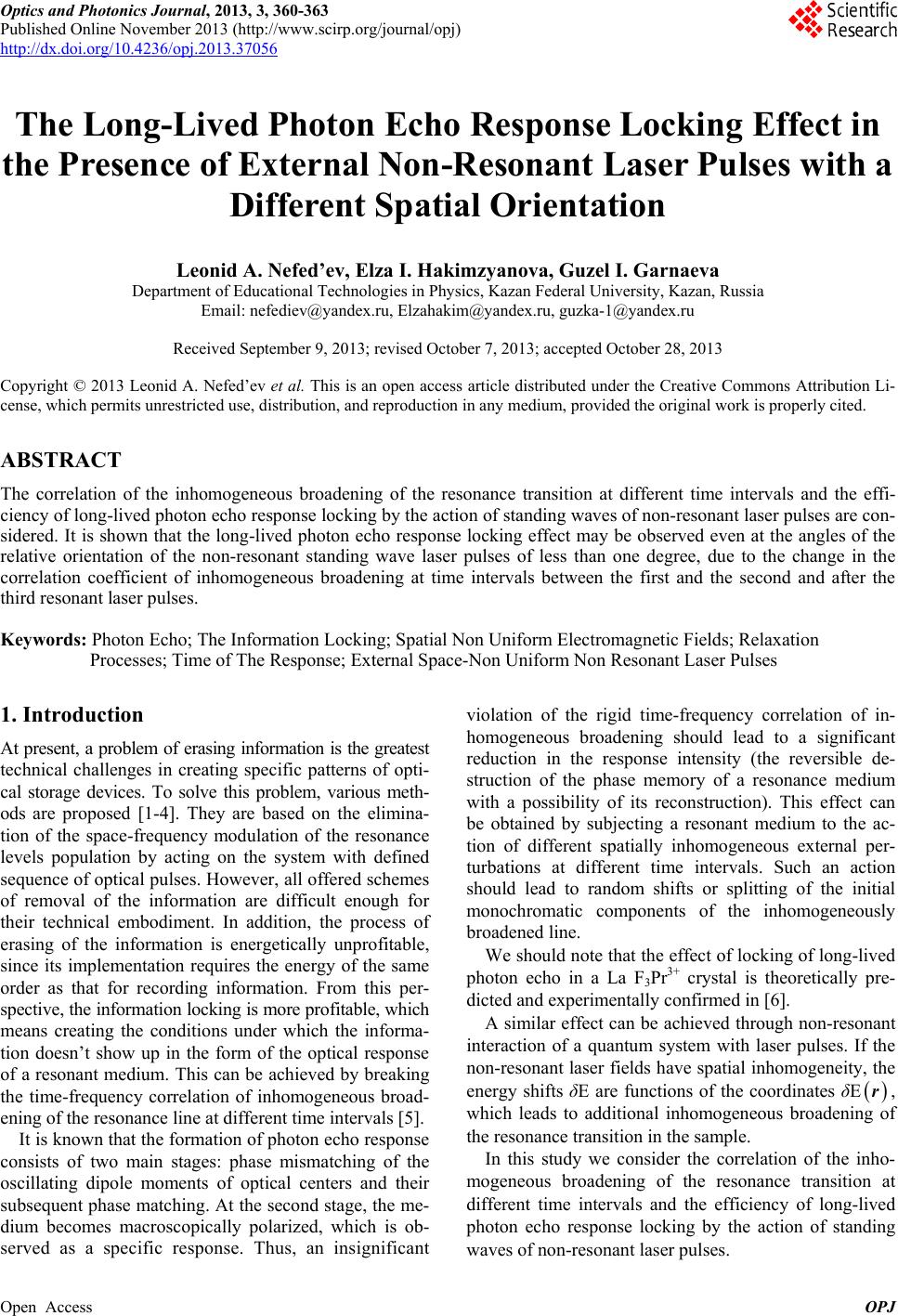
Optics and Photonics Journal, 2013, 3, 360-363
Published Online November 2013 (http://www.scirp.org/journal/opj)
http://dx.doi.org/10.4236/opj.2013.37056
Open Access OPJ
The Long-Lived Photon Echo Response Locking Effect in
the Presence of External Non-Resonant Laser Pulses with a
Different Spatial Orientation
Leonid A. Nefed’ev, Elza I. Hakimzyanova, Guzel I. Garnaeva
Department of Educational Technologies in Physics, Kazan Federal University, Kazan, Russia
Email: nefediev@yandex.ru, Elzahakim@yandex.ru, guzka-1@yandex.ru
Received September 9, 2013; revised October 7, 2013; accepted October 28, 2013
Copyright © 2013 Leonid A. Nefed’ev et al. This is an open access article distributed under the Creative Commons Attribution Li-
cense, which permits unrestricted use, distribution, and reproduction in any medium, provided the original work is properly cited.
ABSTRACT
The correlation of the inhomogeneous broadening of the resonance transition at different time intervals and the effi-
ciency of long-lived photon echo response locking by the action of standing waves of non-resonant laser pulses are con-
sidered. It is shown that the long-lived photon echo response locking effect may be observed even at the angles of the
relative orientation of the non-resonant standing wave laser pulses of less than one degree, due to the change in the
correlation coefficient of inhomogeneous broadening at time intervals between the first and the second and after the
third resonant laser pulses.
Keywords: Photon Echo; The Information Locking; Spatial Non Uniform Electromagnetic Fields; Relaxation
Processes; Time of The Response; External Space-Non Uniform Non Resonant Laser Pulses
1. Introduction
At present, a problem of erasing information is the greatest
technical challenges in creating specific patterns of opti-
cal storage devices. To solve this problem, various meth-
ods are proposed [1-4]. They are based on the elimina-
tion of the space-frequency modulation of the resonance
levels population by acting on the system with defined
sequence of optical pulses. However, all offered schemes
of removal of the information are difficult enough for
their technical embodiment. In addition, the process of
erasing of the information is energetically unprofitable,
since its implementation requires the energy of the same
order as that for recording information. From this per-
spective, the information locking is more profitable, which
means creating the conditions under which the informa-
tion doesn’t show up in the form of the optical response
of a resonant medium. This can be achieved by breaking
the time-frequency correlation of inhomogeneous broad-
ening of the resonance line at different time intervals [5].
It is known that the formation of photon echo response
consists of two main stages: phase mismatching of the
oscillating dipole moments of optical centers and their
subsequent phase matching. At the second stage, the me-
dium becomes macroscopically polarized, which is ob-
served as a specific response. Thus, an insignificant
violation of the rigid time-frequency correlation of in-
homogeneous broadening should lead to a significant
reduction in the response intensity (the reversible de-
struction of the phase memory of a resonance medium
with a possibility of its reconstruction). This effect can
be obtained by subjecting a resonant medium to the ac-
tion of different spatially inhomogeneous external per-
turbations at different time intervals. Such an action
should lead to random shifts or splitting of the initial
monochromatic components of the inhomogeneously
broadened line.
We should note that the effect of locking of long-lived
photon echo in a La F3Pr3+ crystal is theoretically pre-
dicted and experimentally confirmed in [6].
A similar effect can be achieved through non-resonant
interaction of a quantum system with laser pulses. If the
non-resonant laser fields have spatial inhomogeneity, the
energy shifts δE are functions of the coordinates δЕ
r,
which leads to additional inhomogeneous broadening of
the resonance transition in the sample.
In this study we consider the correlation of the inho-
mogeneous broadening of the resonance transition at
different time intervals and the efficiency of long-lived
photon echo response locking by the action of standing
waves of non-resonant laser pulses.